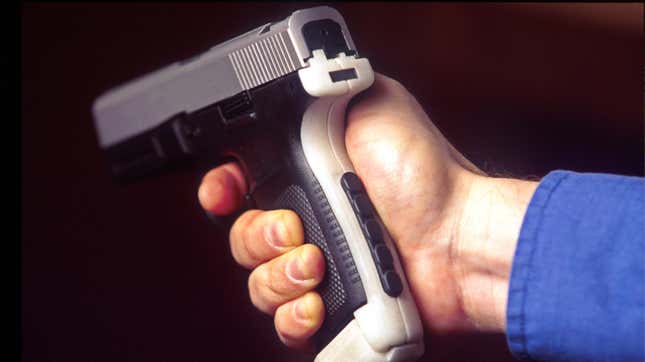
“Smart guns,” the personalized firearms once heralded as tech’s solution to rampant U.S. gun deaths before quietly pittering out of the mainstream conversation, are gearing up for a 2022 comeback.
That news comes via a Reuters report focusing on smart gun makers LodeStar Works and SmartGunz LLC (yes, that’s actually their name) which both plan to have products commercially available late this year. Last week, LodeStar reportedly revealed more details around its 9mm handgun to investors, while SmartGunz claims local law enforcement is beta testing its own personalized handgun. The LodeStar version is reportedly geared towards “first-time buyers” and could cost $895.
“We finally feel like we’re at the point where ... let’s go public,” LodeStar Co-Founder Gareth Glaser told Reuters. “We’re there.”
Supporters of smart guns, which typically use technology like fingerprint scanners or radiofrequency identifying watches, rings, and bracelets to prevent unauthorized users from firing a weapon, argue their wide deployment could help cut down on the number of unintentional suicides resulting from children getting their hands on their parents’ guns. Such a verification system could also potentially prevent other adults from taking or stealing a weapon and using it to harm themselves or others.
LodeStar’s smart handgun opted for multiple points of failure. It reportedly utilizes a fingerprint authentication system, a near field communicator chip accessible by a phone app, and a physical pin pad for instances where the tech is made unusable in wet conditions. SmartGunz meanwhile told Reuters its authentication system focuses on radio frequency identification.
Smart guns as a concept aren’t new. The first iterations date back nearly two decades but have so far struggled to expand beyond prototype stages. The concept has received pushback both from gun control advocates who had expressed concerns over their reliability (one hacker famously unlocked a smart gun using $15 worth of magnets) and from gun rights activists who fear their creation could lead to more stringent firearm regulations.
The biggest names in the firearm industry are also largely absent from the smart gun conversation, though that wasn’t always the case. Smith & Wesson, one of the country’s largest gun manufacturers, in fact, did ink an agreement with the U.S. government to roll out child safe triggers and develop smart guns in 2000, but those efforts faced fervent pushback from the National Rifle Associaton and other pro-gun groups, leading to mass boycotts of Smith & Wesson products, The Washington Post notes. The gunmaker eventually abandoned its smart gun plans Jim the face of plummeting sales and withering stock prices. Since that point, traditional firearms giants have typically steered clear of the smart guns, forcing smaller upstarts to do the heavy lifting on research, development, and commercialization.
That said, it’s still unclear whether American gun owners even want these types of weapons in the first place. According to a 2019 survey of U.S. gun owners featured in the American Journal of Preventive Medicine, around 79% of gun owners who were aware of smart guns said they thought licensed dealers should sell both traditional and personalized smart guns. Yet, when asked if they themselves would actually buy one of these smart guns, just 5% said they were very likely to and only 13% said they were somewhat likely. Only 48% of gun owners were aware of the technology at all. With those stats in mind, it starts to make more sense why LodeStar says it’s gearing its products towards first-time buyers.
Smart guns aren’t the only tech adjacent to firearms seeing a resurgence. Last year, U.S. law enforcement agencies including the Los Angeles Police Department reported an uptick in 3D-printed “ghost guns.” Unlike traditional firearms that are sold as one complete unit, ghost guns are sold in kits that are assembled by a buyer, often using a receiver or other complement that has been created with a 3D printer and crucially without a traceable serial number.
In a statement released late last year, the LAPD claimed it had seized 863 of these supposed ghost guns in the first half of 2021, which marked a nearly 300% increase over the amount it seized during the first half of the previous year, according to the LA Times. The department warned seizures of ghost guns could grow exponentially without proper regulation and deceived the situation as an “epidemic.” Meanwhile, in Philadelphia, authorities seized 250 ghost guns in 2020, up from 99 the year before, according to The New York Times.
If smart gun manufacturers like LodeStar manage to bring a product to market in the coming months and ghost guns continue their upward trajectory, 2022 could represent a crucial year for tech and firearms. Both technologies could also usher in a renewed debate over additional firearm legislation, the extent to which current regulations apply to firearms utilizing these new technologies.